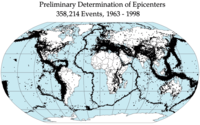
Photo from wikipedia
We performed joint inversions of strong motion, teleseismic, and geodetic data to investigate the rupture processes of three notable (Mw ≥ 6.0) events of the 2016 Kumamoto earthquake sequence. Multi-segment fault models… Click to show full abstract
We performed joint inversions of strong motion, teleseismic, and geodetic data to investigate the rupture processes of three notable (Mw ≥ 6.0) events of the 2016 Kumamoto earthquake sequence. Multi-segment fault models for the three events were constructed based on focal mechanisms, hypocenter distributions of this sequence, and active faults, as well as geodetic features. The results reveal the spatial relationships between the slip distributions of the three events over complex fault planes. In the largest event, the rupture primarily propagated to a northeastern region along the Futagawa fault zone. The extreme pulse-like waveforms observed at the near-fault stations during the largest event can be attributed to the event's upward rupture directivity, slip rate, and the nearly simultaneous slip of two subparallel fault planes.
Journal Title: Geophysical Research Letters
Year Published: 2017
Link to full text (if available)
Share on Social Media: Sign Up to like & get
recommendations!